|
|
Post by 1dave on Nov 26, 2016 12:45:50 GMT -5
Grinding Weight - viscosity - grit size - barrel size - PVC vs Rubber - slurry properties - speed - stone sizes - Tumble vs vib - how many stages? Who can put it all together?
|
|
budified
off to a rocking start

Member since November 2016
Posts: 21 
|
Post by budified on Nov 26, 2016 13:04:48 GMT -5
I love the way you guys analyze the $#!+ out of everything!
When hobby turns to passion amazing revelations can be discovered.
|
|
jamesp
Cave Dweller 
Member since October 2012
Posts: 36,607
|
Post by jamesp on Nov 26, 2016 13:09:52 GMT -5
Grinding Weight - viscosity - grit size - barrel size - PVC vs Rubber - slurry properties - speed - stone sizes - Tumble vs vib - how many stages? Who can put it all together? Well, the crappy sandy red clay carries grit for 2 days, the less sandy red clay did 3-4, and the real pasty red stuff(we say heavy/sticky/greasy/slick/@#$%^) runs and runs. Straight white kaolin was slow to pick up the grit at start up. That was a problem. Not so with the reds, no matter sand content. The less sand the deeper the rust color in most cases. So figure the iron content goes up with performance too if that means anything. Some of it is really rust colored, not so much in Atlanta. Bartow county is dark rusty RED, a geologically complicated county. So there is no doubt about the more pure red clay. It may work in any rotary tumbler for coarse grit(the target), regardless. Assuming proper water percentage(viscosity). Got to get that right. After that all is user friendly. Rock size, speed, grit size, 6 or 8 inch barrels, all of those seem to have little effect. Been there done that. Except small 3 pound barrels. |
|
jamesp
Cave Dweller 
Member since October 2012
Posts: 36,607
|
Post by jamesp on Nov 26, 2016 13:13:43 GMT -5
I love the way you guys analyze the $#!+ out of everything! When hobby turns to passion amazing revelations can be discovered. All this clay saga got started trying to get coarser grits to suspend in slurry and create attraction forces to speed up the slowest part of tumbling-the shaping process. That's it in a nut shell. Tired of waiting 12-16 weeks shaping rocks. |
|
budified
off to a rocking start

Member since November 2016
Posts: 21 
|
Post by budified on Nov 26, 2016 13:26:19 GMT -5
Which is why you have a bench grinder with a grinding stone on it.
My question is, how thick should a slurry be?
I assume somewhere between egg-nog and thick gravy, but how do you guys describe a properly viscous slurry?
|
|
jamesp
Cave Dweller 
Member since October 2012
Posts: 36,607
|
Post by jamesp on Nov 26, 2016 13:49:41 GMT -5
Which is why you have a bench grinder with a grinding stone on it. My question is, how thick should a slurry be? I assume somewhere between egg-nog and thick gravy, but how do you guys describe a properly viscous slurry? Milk shake. Viscosity hard to put in words. Slump test would probably work, but never quantified for tumbling slurry. If you can move the barrel and can see the slurry moves freely you are close. NOT watery. If you hear the rocks not rubbing/bumping then likely to thick. Pour some off and add water to thin. |
|
metalsmith
Cave Dweller 
Member since October 2012
Posts: 1,537
|
Post by metalsmith on Nov 26, 2016 15:29:49 GMT -5
I'm not sure what it is you'd like to know about clay ... try this, or this  |
|
metalsmith
Cave Dweller 
Member since October 2012
Posts: 1,537
|
Post by metalsmith on Nov 26, 2016 15:36:22 GMT -5
The sticky nature is due to shapes of particles... The sticky nature is due to the electro-static charges of the particles refNo doubt the shape, chemistry and ionic behaviour are all inescapably linked. I hope you guys are signed up for PhD's...  |
|
jamesp
Cave Dweller 
Member since October 2012
Posts: 36,607
|
Post by jamesp on Nov 26, 2016 16:22:50 GMT -5
The sticky nature is due to shapes of particles... The sticky nature is due to the electro-static charges of the particles refNo doubt the shape, chemistry and ionic behaviour are all inescapably linked. I hope you guys are signed up for PhD's...  That's not gonna happen(PHD's) lol. Not me anyway. However, numerous trails will tell things that those PHD's may never figure out. For one thing, it works. #1 deductionconclusion. Surpasses the importance of all other knowledge. But like 1dave, @shotgunner, jamesp, others and likely metalsmith the why's and the what's got to be looked at. Often the reason is right there. Curiosity best satisfied. |
|
jamesp
Cave Dweller 
Member since October 2012
Posts: 36,607
|
Post by jamesp on Nov 27, 2016 9:38:41 GMT -5
Higher sand content left, low to right 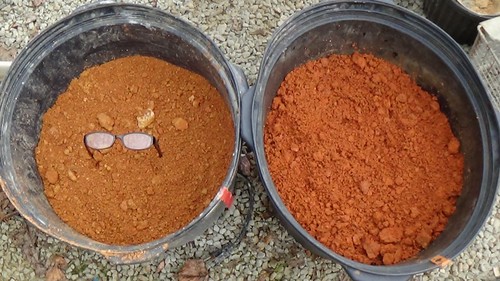 Sticks to boots and ATV tires 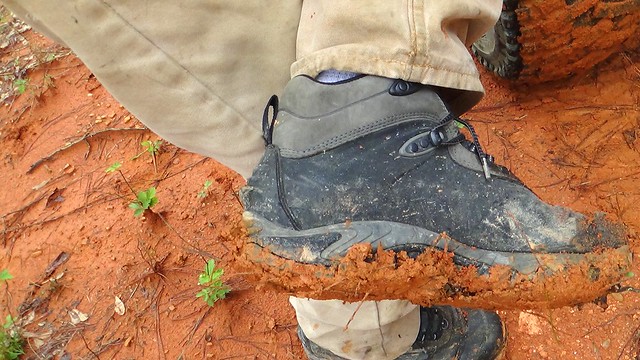 Top-of-hill rich clay source a half mile thru woods behind house. Hill top clay ofter rich. Erodes slower leaving hills... Logging road shoulder. If it sticks to the tires when damp it will work in the tumbler. Simple test criteria. 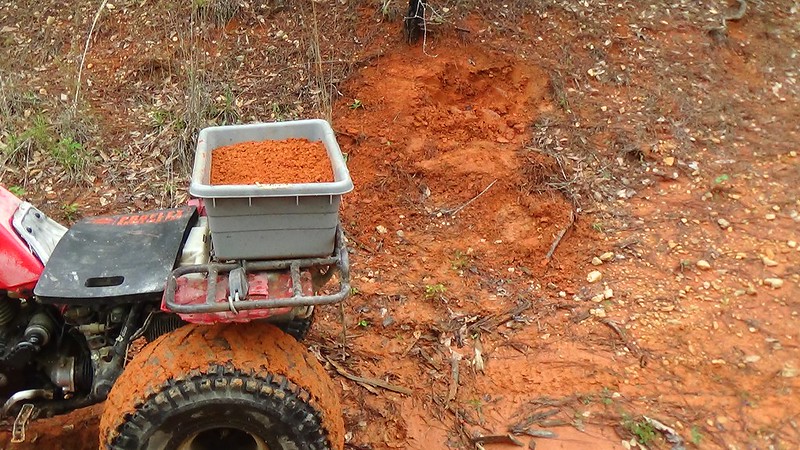 |
|
jamesp
Cave Dweller 
Member since October 2012
Posts: 36,607
|
Post by jamesp on Nov 27, 2016 9:44:39 GMT -5
|
|
|
|
Post by 1dave on Nov 27, 2016 9:47:40 GMT -5
 PHD's are mostly smoke and mirrors. Clay studies are for specific subjects - farming, construction, pottery - HERE James has initiated a NEW IDEA, How to speed up tumbling. What happens in a steep river? Rocks roll and bang into each other, shattering, bruising, pitting. As the river enters the lowland those fractured rocks are rounded and smoothed by the particles around them. Rock lovers have been trying to improve on Ma Nature. Build a tumbler - add rocks and water - No good. Add rocks and grit - no good. Add rocks, grit and water - better. Add rocks, grit, water, AND slurry - Voila! (“ see!, look! ”) a huge savings in time. Now, how to simplify all the clay studies to help with improving the process even more? |
|
|
|
Post by 1dave on Nov 27, 2016 9:58:10 GMT -5
Various red clays for various sections of baseball field Another supplier, home plate clay  Great detail in building sections of ball fields  OUCH! Reminded me of my first day at a brand new high school in Wichita Kansas. In gym shorts I slid into second base. The contractor had used CRUSHED SAND between bases. Shredded my whole left side. I should have sued. |
|
jamesp
Cave Dweller 
Member since October 2012
Posts: 36,607
|
Post by jamesp on Nov 27, 2016 10:18:46 GMT -5
 PHD's are mostly smoke and mirrors. Clay studies are for specific subjects - farming, construction, pottery - HERE James has initiated a NEW IDEA, How to speed up tumbling. What happens in a steep river? Rocks roll and bang into each other, shattering, bruising, pitting. As the river enters the lowland those fractured rocks are rounded and smoothed by the particles around them. Rock lovers have been trying to improve on Ma Nature. Build a tumbler - add rocks and water - No good. Add rocks and grit - no good. Add rocks, grit and water - better. Add rocks, grit, water, AND slurry - Voila! (“ see!, look! ”) a huge savings in time. Now, how to simplify all the clay studies to help with improving the process even more? Ceramic Engineering. Big time engineering discipline at Georgia Tech. Study includes clay for pottery, insulators, slurries, industrial uses, etc. Aluminum oxide is one of the most used ceramics, and most varied. Altered by elements, compounds, heat. Clay a serious source of AO. Silicon carbide is also considered a (mostly man made)ceramic. Most abrasives are ceramics for that matter. Mining operations mix clay into water to float ore particles for instance for easy transfer using pumps and pipes. They use mass quantities of clay. Send it to settlement ponds after the ore has been separated from it. Georgia being world leader in kaolin production probably birthed the Ceramic Engineering school at Ga Tech. Old timers were firing pottery out of it long before clay became valuable to industry. Appalachian face jugs: Dave:  James:  @shotgunner 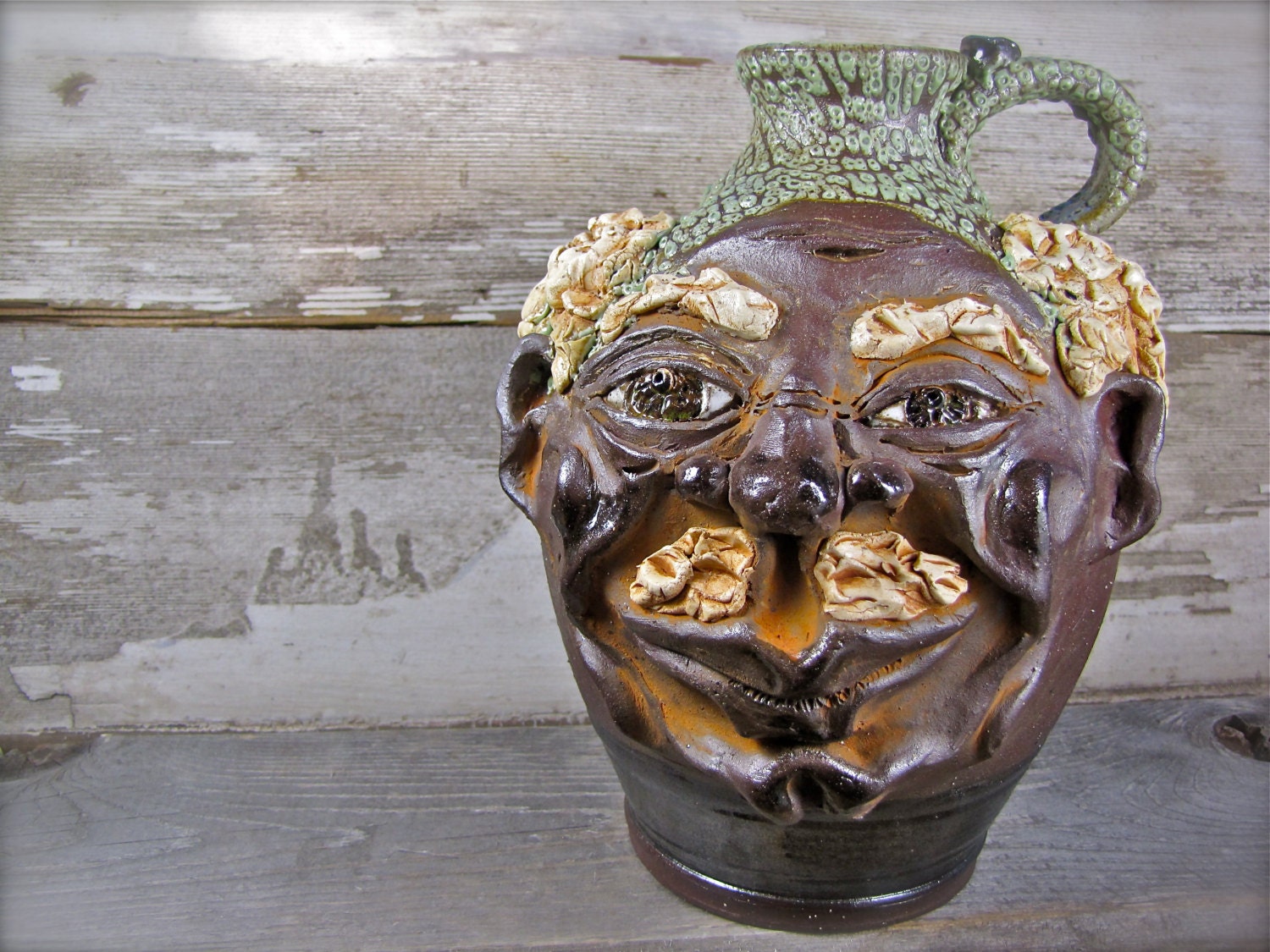 Jugglerguy Jugglerguy |
|
|
|
Post by 1dave on Nov 27, 2016 10:34:02 GMT -5
 Do I need to change my avatar? |
|
jamesp
Cave Dweller 
Member since October 2012
Posts: 36,607
|
Post by jamesp on Nov 27, 2016 11:22:39 GMT -5
But one avatar for Dave  |
|
Deleted
Deleted Member
Member since January 1970
Posts: 0
|
Post by Deleted on Nov 27, 2016 11:28:49 GMT -5
Lmao, literally laying in bed laughing my ass off.
Pleased my jug has a moustache. Can't grow one, so at least my jug has one.
|
|
|
|
Post by 1dave on Nov 27, 2016 19:50:13 GMT -5
But one avatar for Dave  Not representative. Caught in a calm mood. |
|
Deleted
Deleted Member
Member since January 1970
Posts: 0
|
Post by Deleted on Nov 27, 2016 22:06:26 GMT -5
But one avatar for Dave  Not representative. Caught in a calm mood. Almost missed it. Happy bday Mr. Dave!! |
|
|
|
Post by 1dave on Nov 28, 2016 7:18:15 GMT -5
1. Collecting for tumbler: Nice sampling, just the tip of the iceberg? That's a heck of a turnaround time. Lot of variety on the Rio. Been there done that place before. This time rocks were carefully selected with tumbling in mind. Size, shape, solid, smooth, lack of patina, lack of divots. As ready to tumble as possible. It is a tumbler's paradise. A lot of the bigger slab size rocks have been taken. Tons of high grade tumble size rocks just waiting be collected. Many small high grade agate/jasper/chert biscuits that could be center tapped with a hammer to 3-4 pie cut shapes. Easy fodder for the tumbler. Wished I had taken photos of the tumble size pebble shore lines at higher fixed lake levels. Collecting rate about one 1"-2" pebble per 3 seconds. Fill your buckets. The wood you about have to saw. So get bigger pieces. It breaks jagged with a hammer. Messy 2. Setting up Tumbler: (What % Slurry?) 3. Speeding up tumbling time: Threw everything at them. Slurry,small doses coarse grit almost daily, some pre-grinding. Two clean outs. 60% fill. Finished in turned up vibe using only AO 500 for a day, some 2 days. Lightbox flickr link www.flickr.com/photos/67205364@N06/31230043065/in/album-72157673064411694/lightbox/4 woods, 4 jaspers Mac contact sheet, turned sideways and cropped in flickr's Aviary photoshop 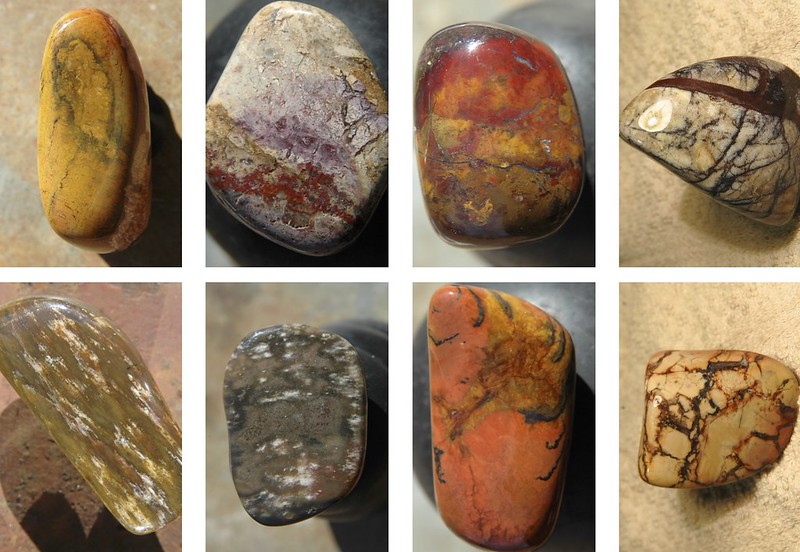 Contact sheet using Mac on solid Texas pet wood 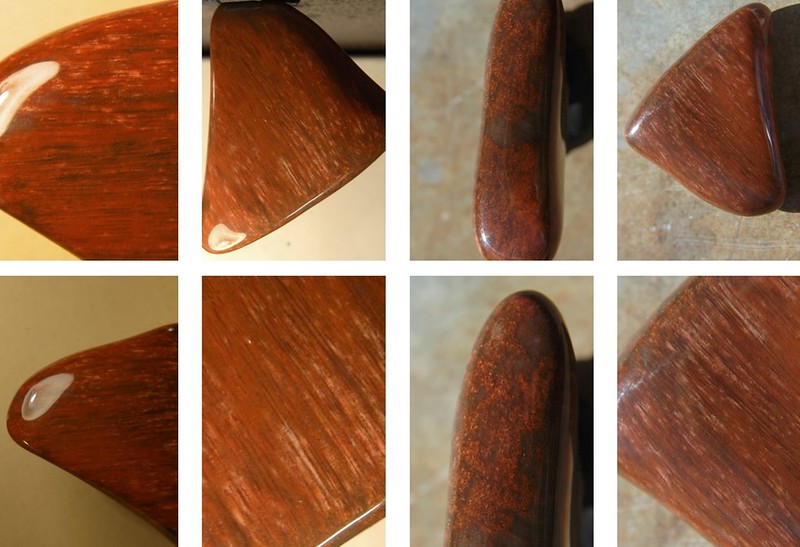 On a multicolored but fractured jasper 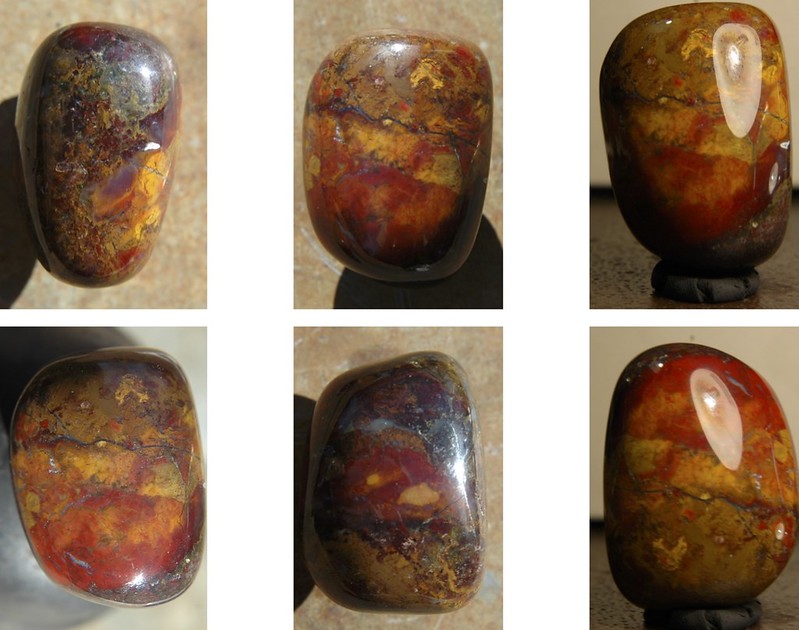 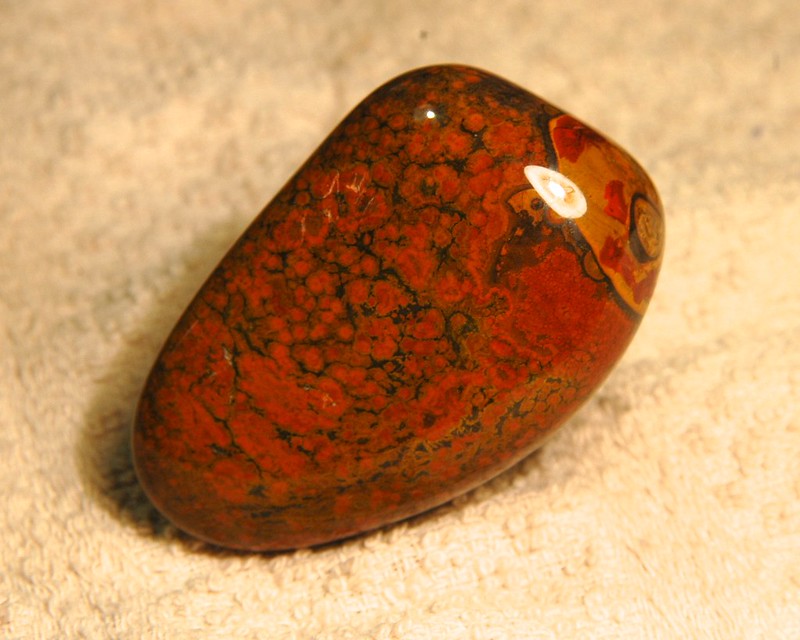 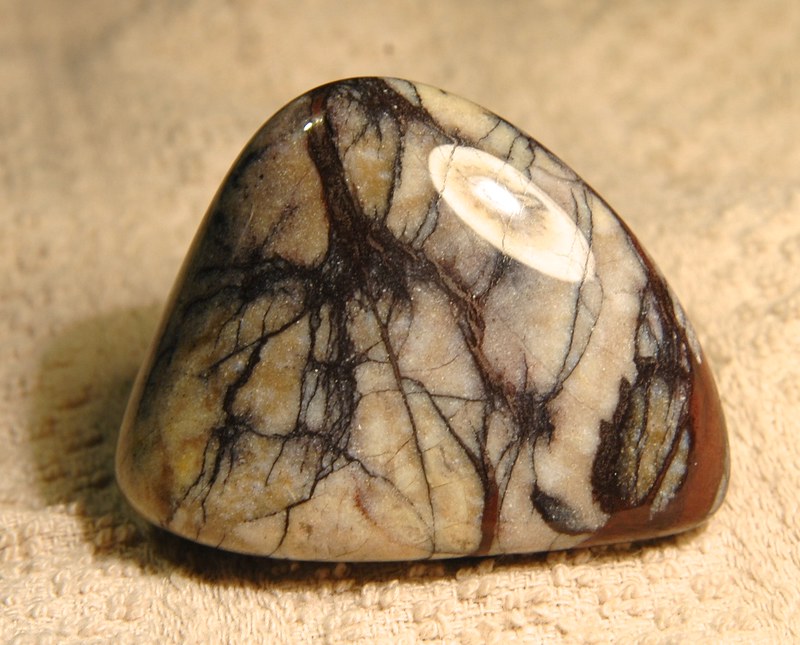 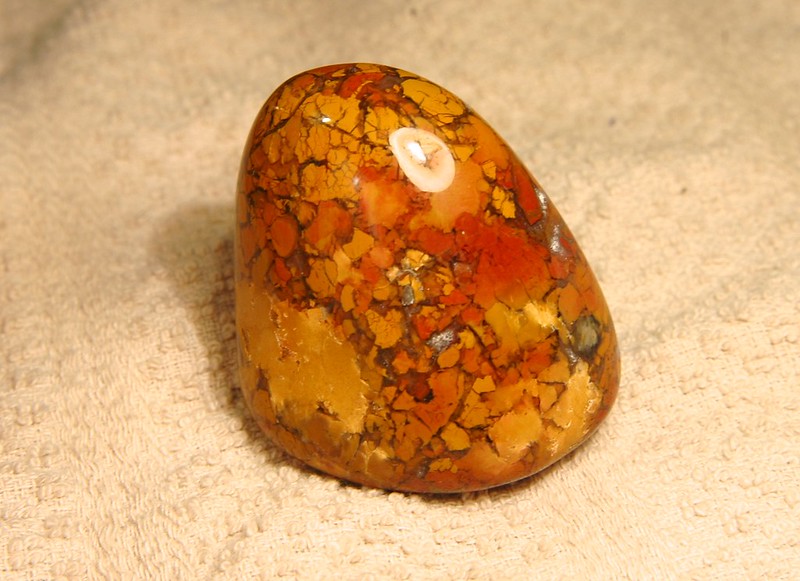 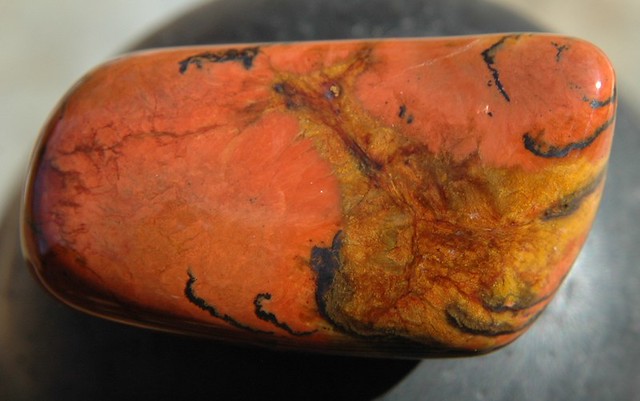 |
|